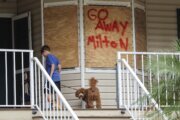The Centers for Disease Control and Prevention has deemed insufficient sleep a public health epidemic, making people more susceptible to chronic diseases such as diabetes, depression, hypertension and obesity, in addition to cancer and an increased risk of death. And while an estimated 50 to 70 million American adults suffer from a sleep disorder, a 2014 poll from the National Sleep Foundation revealed that many kids themselves aren’t getting the shuteye they need.
The consequences of insufficient sleep can be just as damaging to children as to adults, setting the stage for little ones to pack on pounds, develop high blood pressure and prediabetes, and experience lower pain tolerance and immune system function. And the harmful effects don’t end there.
“Studies have clearly demonstrated that even a little bit of sleep loss — for example, 30 to 60 minutes per night — is enough to cause a child to have difficulties with concentration, sitting still and paying attention, all of which are required for a child to learn and be successful in school,” says Lisa Meltzer, associate professor of pediatrics at National Jewish Health in Colorado. “Younger children may become more hyper and have increased behavioral problems, while older children and adolescents may become more moody, irritable and withdrawn.”
Sarah Morsbach Honaker, a pediatric sleep psychologist at the Riley Sleep Disorders Center at Riley Hospital for Children at Indiana University Health in Indianapolis, adds that sleep-deprived children may be more prone to “risky behaviors such as substance use, and in some cases, even suicidality.”
In fact, a study published in Pediatrics in 2012 showed that children suffering from disordered breathing during sleep — which can contribute to sleep loss — such as snoring, breathing through the mouth or apnea, where a child may stop breathing for seconds or even minutes at a time, have a higher incidence of behavioral and emotional issues such as aggression, anxiety, hyperactivity and depression.
“Children have maturing brains, therefore their sleep needs are longer,” says Ameet Daftary, medical director of the sleep program at Riley Hospital for Children at Indiana University Health. Just how long? Many medical experts commonly refer to the guidelines established by the National Sleep Foundation, which lays out sleep recommendations for every age group: Toddlers should clock a minimum of 11 hours; preschoolers need at least 10, school-aged children should get at least nine; and teenagers should get no less than eight.
An important thing to keep in mind, says Honaker: “These ranges reflect the amount of time the child is actually asleep, rather than the amount of time a child is in bed. So if a child has an 8:30 p.m. bedtime and wakes at 7 a.m., but generally does not fall asleep until 9 p.m., the total sleep duration would be 10 hours.”
Is your child getting enough sleep? Probably not if he or she often experiences one or more of the following:
— Difficulty waking up in the morning: “Children should be able to wake up and get going within about 15 minutes,” Meltzer says.
—
— Falling asleep during the day: There may be a tendency to fall asleep at inappropriate or unusual times during the day, Honaker says, such as during class or very short car rides.
—
— Feeling extreme daytime fatigue: Honaker notes that the child will seem to have low energy or motivation, particularly at certain times of the day such as the afternoon.
—
— Sleeping an additional hour or two on weekends or holidays, which Meltzer says “is a sign of a child who is trying to catch up on her sleep.”
For many children, lack of sleep can be attributed to too much technology. “Screens and devices can emit enough light to suppress melatonin, a naturally produced hormone needed to regulate the internal clock and facilitate sleep,” Meltzer explains. “All of these devices have on/off switches, but our brains have more of a dimmer switch, needing time to wind down and shut off prior to sleep.”
Schools also play a large role, with start times often occurring before 8 a.m., forcing adolescents to wake up early and skimp on sleep, Meltzer says. And when you consider that many children are overscheduled with homework and extracurricular activities, “something has to give, and that is often sleep, with children staying up late to get everything done.”
If a child consistently snores, even when both sick and well, or is excessively sleepy during the day despite getting what appears to be sufficient sleep for her age, then a visit to the pediatrician or an accredited sleep lab, which may be covered by insurance, could be necessary.
“Sleep studies are very beneficial in analyzing breathing and behaviors during sleep,” Daftary says. “[They] can detect if restlessness during sleep is due to abnormal breathing patterns or movement disorders. And when combined with an EEG [a test that records electrical activity in the brain], it can help determine abnormal sleep-associated behaviors such as seizures.” Sleep studies can also assist in identifying unusual breathing patterns, and whether tonsil and adenoid surgery, often used to treat sleep apnea, may be needed.
While a sleep study may not be able to answer every question about a sleep concern, says Daftary, it can be quite useful when a physician needs specific information about a child’s sleep patterns.
What does a sleep study entail? “It is painless and involves spending the night with a parent or guardian in the sleep lab,” says John Schuen, director of the Pediatric Sleep Disorders Center at Helen DeVos Children’s Hospital in Michigan.
The child, usually encouraged to bring a favorite teddy bear or blanket, is escorted to a room with a bed by a pediatric sleep technician, often a kind and patient person who follows the lead of the family in order to make the child feel comfortable, Schuen says. After changing into pajamas, wires are attached to the child’s scalp and temples; a nasal cannula is placed under the nose; bands are wrapped around the chest and abdomen; and a pulse oximeter is put on the finger or toe.
“These different applications look at brain waves, eye movement, airflow, breathing effort, oxygenation and carbon dioxide level,” Schuen explains, as a night vision camera records movement and sound. Then the lights are turned off and the child is encouraged to fall asleep. After a night of observation, the technician usually wakes the family around 6 or 7 in the morning, and all monitoring equipment is removed.
Though sleep studies are often used to diagnose serious conditions like obstructive sleep apnea in a snoring child — “it is the gold standard for the diagnosis of these disorders,” Meltzer says — there are tips and techniques parents can use at home to help improve their child’s sleep. Vigorous physical activity during the day will help a child sleep better at night, Schuen says. So will establishing a regular nightly routine and keeping a consistent bedtime. Turn off all electronics, video games, televisions, computers and, yes, smartphones at least 30 to 60 minutes before bedtime. And, Meltzer adds, have a sleeping environment that is cool, comfortable and technology-free. Sweet dreams.
More from U.S. News
Top Reasons Children End Up in the Hospital
10 Essential Items to Pack in Your Child’s Hospital Bag
Sleep-Starved Kids: the Dangers of Catching Too Few Winks originally appeared on usnews.com







